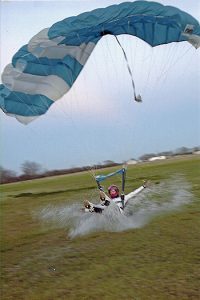Ah spring… Green grass, warming temperatures, and RAIN! One of the most common questions we see in our social media news feeds this time of the year is, “How wet is the landing area?” If you have to ask, the answer is usually “underwater.” 😉

Since we’re not too interested in waiting days for perfectly dry ground to skydive, that means we have at least a fair chance of landing in a puddle from time to time. As you might have already discovered, it’s far from the end of the world! However, there are a few things that can help you land more safely and better manage your gear.

- Puddles are the last hazard to avoid. Water won’t hurt you unless it’s deep enough to drown in and you can’t swim. Plan your landing pattern to avoid obstacles and people first, puddles last.
- Don’t dodge puddles if you’re on final. Since no one WANTS to land in the water, it’s very tempting to turn a little left or right to avoid a puddle when you’re about to land. However, remember two things: One, low turns can hurt you a whole lot more than a little water! Two, other skydivers may be flying near you, and your turns may cause them to turn low to avoid you and thereby risk injury. Not cool!
- Water and mud are super slick–be ready to PLF! Whether you’re touching down in a puddle or slick mud (and you know how slick that gumbo mud can be here in south Texas!), chances are very good that you may slip and fall. As funny as it can be for the rest of us to watch others trying to stay on their feet in this scenario, it can increase your risk of injury. Just like if the ground were dry, always be prepared to PLF if your landing isn’t going as planned.
- Once you’re down, hop up quick to get the rig out of the water. If the container soaks in water for any length of time, it will have to be dried before it can be repacked, meaning you can’t jump it again for awhile. And if the reserve container gets soaked, there’s a reserve inspection and repack in your future and that rig is down for even longer. Thirdly, there is the risk that if the reserve container gets very wet, your automatic activation device (AAD, Cypres in our rigs) may have gotten wet enough that it will need maintenance as well–>more potential downtime. This is why sometimes when it is very wet, we’ll put rental gear on hold–more people will get to jump the gear if we wait till it’s a little drier than if all of our rigs end up in the loft waiting to dry and be repacked.
- Pick the canopy up out of the water quickly as well. If your canopy lands in standing water, pick it up as quickly as you can rather than waiting until after you’ve removed helmet/goggles, etc. The packers won’t pack a wet canopy, so if you want to jump that rig again soon, pick it up quick to minimize its soaking time! Make sure you have every bit of the gear off the ground before carrying it in, as always.
- If your jumpsuit or shoes get significantly muddy, you can hose them off out back by the observation deck or between the hangars.
- If your rig gets significantly muddy, it’s usually best to scrape off any clinging mud, then let the rig dry thoroughly before using a brush to knock the rest of it out of the fabric. If you brush it wet, you’re just cramming the dirt deeper into the fabric.
 Not sure if your rig needs any special care after a wet landing? Ask one of the packers or instructors for help if you’re not sure how to handle your wet gear. If the rig needs cleaning and a repack, you will incur some charges from the riggers whether you are jumping your own gear or renting gear.
Not sure if your rig needs any special care after a wet landing? Ask one of the packers or instructors for help if you’re not sure how to handle your wet gear. If the rig needs cleaning and a repack, you will incur some charges from the riggers whether you are jumping your own gear or renting gear. - Bring dry shoes and socks to wear after jumping. Don’t waste your last pair of dry socks and shoes on another water landing, but it sure is nice to have dry feet for the evening and on the way home.
Follow these tips to land safely and manage your gear when jumping in the wet, and remember we have showers in the bunkhouse if your mud landing is truly epic. 🙂
Top photo by JP Furnari

